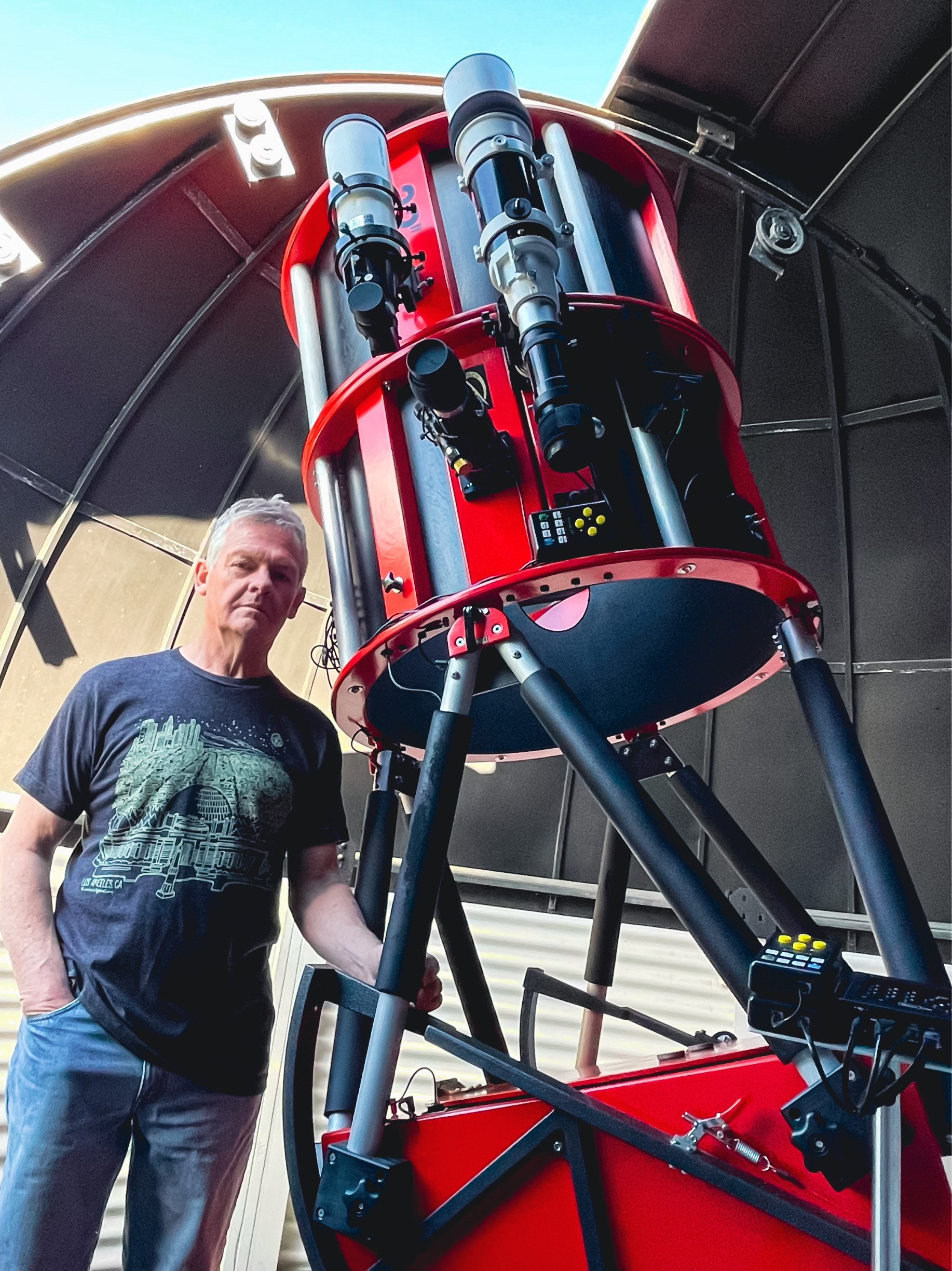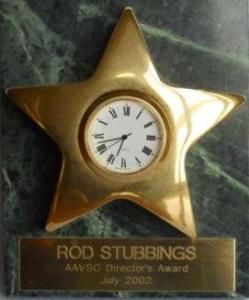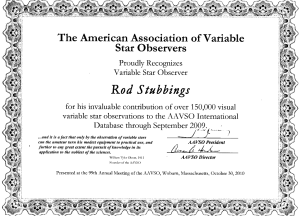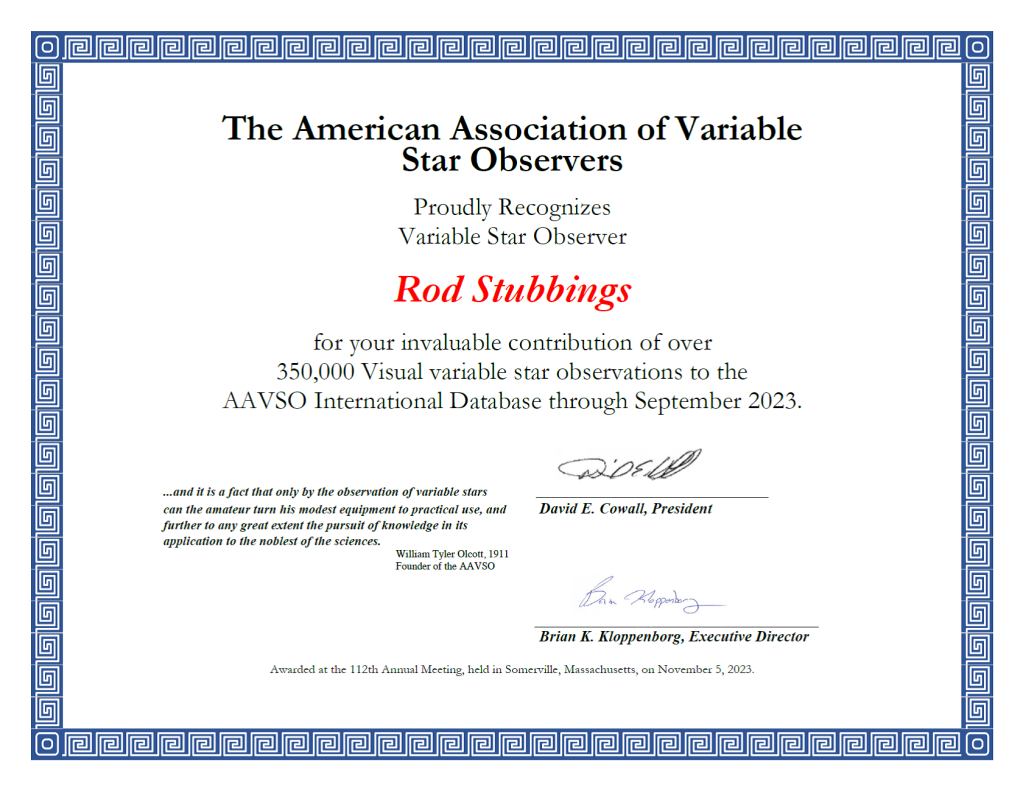My name is Rod Stubbings, and for 30 years now, I have been an amateur astronomer residing in Tetoora Road, Victoria, Australia…. or more or less in my observatory for the majority of!
 My introduction to Astronomy started in 1986 while reading a magazine. It showed a 60mm refractor with stunning pictures of the Planets, which could be seen with a magnification of 500X! Well, it was ordered immediately, and I eagerly awaited its arrival. With my new telescope, I headed outside to see these planets. No, not that one; it must be this one, etc. I could not find anything and even had trouble focusing on the stars. I went back inside, a little deflated by the whole situation. Not to be deterred, I headed to the newsagents for some books on astronomy. My choice was ‘Stargazing’ Astronomy without a Telescope by Patrick Moore. This book showed the names of the brightest stars in each constellation with lots of well-known objects, double stars and, of course, where to find these elusive Planets; thus, my observing career started.
My introduction to Astronomy started in 1986 while reading a magazine. It showed a 60mm refractor with stunning pictures of the Planets, which could be seen with a magnification of 500X! Well, it was ordered immediately, and I eagerly awaited its arrival. With my new telescope, I headed outside to see these planets. No, not that one; it must be this one, etc. I could not find anything and even had trouble focusing on the stars. I went back inside, a little deflated by the whole situation. Not to be deterred, I headed to the newsagents for some books on astronomy. My choice was ‘Stargazing’ Astronomy without a Telescope by Patrick Moore. This book showed the names of the brightest stars in each constellation with lots of well-known objects, double stars and, of course, where to find these elusive Planets; thus, my observing career started.
My general interest in astronomy continued for a few years, and I eventually went to a local astronomy club, The Latrobe Valley Astronomical Society LVAS, where I met Peter Nelson. Peter was always writing articles on variable stars and trying to get someone (and the more I’ve thought about it, “bait” someone) to go out and make some observations. At this point, I was looking at the same objects each night, so I thought I could put my time to better use observing variable stars and contributing to science. The bait was taken, and with my basic knowledge of the night sky, I set out to find out about these variable stars.
The Royal Astronomical Society of New Zealand (RASNZ) variable star section was founded in 1927 by the late Dr Frank Bateson, OBE (1909-2007). It became the recognised centre for Southern Hemisphere variable star research. Armed with a beginner’s book on “The Observations of Variable Stars” from the (RASNZ), I made my first variable star observation on the Mira star R Cen in May 1993.
My first month observing variable stars produced 10 observations, with countless hours of star hopping and locating variable star fields. I progressed through the stages of watching from the naked eye, binoculars, 60mm, 150mm, 250mm, 320mm, 400mm and currently, a 550mm custom-made reflecting telescope. The transition from each instrument was always a new learning curve with more stars and deeper fields to which to get accustomed.
 I started to monitor the dwarf novae class of variable stars for outbursts. Over the next few years, I detected many outbursts recorded in my logbook and sent to RASNZ monthly. With the Internet starting to make a presence, I came across the Variable Star Network (VSNET), a global professional-amateur network of researchers in variable stars and related objects alert mailing lists, which reported outbursts of stars. Reading the VSNET alerts, I realised that I had also observed the outbursts mentioned, plus a few others that were not reported. There was no point in keeping my outburst detections in my logbook, so I sent every detection to VSNET in 1997, which was quite a few per night!
I started to monitor the dwarf novae class of variable stars for outbursts. Over the next few years, I detected many outbursts recorded in my logbook and sent to RASNZ monthly. With the Internet starting to make a presence, I came across the Variable Star Network (VSNET), a global professional-amateur network of researchers in variable stars and related objects alert mailing lists, which reported outbursts of stars. Reading the VSNET alerts, I realised that I had also observed the outbursts mentioned, plus a few others that were not reported. There was no point in keeping my outburst detections in my logbook, so I sent every detection to VSNET in 1997, which was quite a few per night!
A few weeks later, I received an email from Frank Bateson, ‘You may receive emails resulting from your alert messages requesting additional data. If you do, I suggest you tell the enquirer to contact me so they can obtain our complete record. I have already received such requests from those who know you are one of our observers, but others may not know of this connection.’
Two months later, another email from Frank, ‘I returned at the end of last week from the meeting in Switzerland. You will be pleased to know that your alert notices are being well-regarded worldwide. Keep up the good work.’ So, I was happy to keep sending every outburst detection to VSNET.
I was now averaging over 1400 observations and detecting between 30 – 50 dwarf novae outbursts each month. In 1999, I recorded over 17,500 observations. All outbursts detected each observing night were sent via alert messages to VSNET and the RASNZ. I followed the rise and fall of each outburst until it faded, posting nightly observations.
I started to concentrate on the many poorly studied fainter cataclysmic variables. This involved a lot of stars that were having outbursts at magnitudes 15.0 to 15.6. With constant monitoring, I would record their maximum brightness, frequency, and duration and follow the rise and fall of many outbursts. All this information was previously unknown. Typically, when I detected an outburst, I would send an alert notice, which enabled observers worldwide with CCD detectors to observe these stars. Many interesting results were found when notifications of these outbursts were subjected to CCD time-series observations. The data showed many unknown stars belonged to the exclusive SU-UMa and WZ Sge-type dwarf novae. The CCD data are sent to the VSNET team at Kyoto University in Japan for analysis, and the results are announced and published.
 My involvement with the American Association of Variable Star Observers AAVSO, the world’s largest variable star organisation, began in 1997. I received an email from the Director Dr Janet Mattei (1943-2004): “If you would be interested in sending your observations directly to the AAVSO, in addition to the other networks to which you send them, we would very much like to include your observations in the AAVSO News Flashes”. This was a further encouragement to continue observing, especially from the Director of the AAVSO.
My involvement with the American Association of Variable Star Observers AAVSO, the world’s largest variable star organisation, began in 1997. I received an email from the Director Dr Janet Mattei (1943-2004): “If you would be interested in sending your observations directly to the AAVSO, in addition to the other networks to which you send them, we would very much like to include your observations in the AAVSO News Flashes”. This was a further encouragement to continue observing, especially from the Director of the AAVSO.
On June 8, 2002, in my 9th year of observing, I recorded 100,000 visual observations, which was never considered in 1993. This achievement was made on a Star, KK Telescopium, a SU UMa-type dwarf nova. I believe I was the first Australian observer to reach 100,000 visual observations.

On July 19, 2002, I was checking my email and noticed a message from the Director of the AAVSO, Dr Janet Mattei, titled, ‘Invitation’. It was an invitation to attend the Pan-Pacific, 91st Spring Meeting of the AAVSO, held at Waikoloa Beach, Hawaii, to receive a Director’s Award……” for your very significant contributions to variable star astronomy, particularly to special observing programs.”
After reading the contents several times, I felt very honoured, but I could not possibly attend this meeting. After all, I have not even travelled out of my own state, let alone on a plane. Thankfully, Janet encouraged me to attend, and the realisation of stepping onto an international plane and travelling overseas to the Big Island of Hawaii was about to come true.

Having been in contact with several observers via email, the meeting provided great satisfaction with finally seeing the faces of many talented observers and amateur astronomers. I introduced myself to Janet Mattei (after all, no one knew this guy from Australia) and was greeted with a warm hug! Finally, meeting the staff members was also rewarding for both parties, as I had been only known as ‘SRX’ (observer code) at headquarters. Being my first AAVSO meeting, listening to talks and enjoying the social activities was an experience I consider myself very fortunate to have been a part of.

My main interest in variable stars has been Cataclysmic Variables (CVs) and Dwarf Novae (DNe), although I am now adding more types to my observing list. In the field of variable star astronomy, “outbursts” of Cataclysmic Variables and their physics are of particular interest to professionals. As professionals have to schedule observing time at large observatories up to a year in advance, these outbursts would otherwise go unobserved. As thousands of these stars are unstudied in the southern skies, there is a need to try and cover more of these objects.

The novel field of “Transient Object Astrophysics” is becoming a rapidly growing field of astronomy. These events include outbursts of X-ray transient and cataclysmic variables. I have been involved in many professional–amateur collaborations with VSNET, AAVSO, and RASNZ, which required ground-based and satellite observations.

Over the years, I have been honoured to receive many requests from astronomers worldwide for notifications on specific stars that went into outbursts to assist their research programs. It is surreal that my observations have directly triggered satellite observations with the EUVE and XTE satellites, ROSAT X-Ray astronomy satellite, European X-ray satellite BeppoSAX, Hubble Space Telescope, Chandra X-Ray Observatory, Ultraviolet Space Observatory (FUSE), XMM-Newton space observatory, Swift Space Observatory and The Neutron star Interior Composition Explorer (NICER).
On January 24, 2012, another personal milestone was reached when I recorded my 200,000th visual variable star observation on the recurrent nova T Pyx, which was visible at magnitude 12.5. This was achieved in 18 years and 8 months, and the 7th visual variable star observer in the world to have reached this milestone in the history of variable star astronomy.

In May 2014, I received an email from Linda Shore, the Director of the Astronomical Society of the Pacific, informing me that I had been selected as the 2014 recipient of the Amateur Achievement Award. This award recognises significant observational achievement by an amateur astronomer. It included a cash award, an engraved plaque, and travel and lodging to accept the award at a banquet in San Francisco.

* Citation* “recognises significant observational or technical achievements by an amateur astronomer to Rod Stubbings, a visual observer who has been responsible for notifying the astronomical community of rare or important outbursts of cataclysmic variables for nearly two decades. If it were not for his persistent coverage of the southern sky, we would have missed outbursts of recurrent novae and WZ Sge-type objects entirely. He has been referred to as a southern hemisphere fire spotter who notifies the astronomical community so they can throw water on these “fires” as they erupt with their CCDs and spectrographs. In 2012, Rod passed the 200,000 observation mark, one of only a handful of observers to ever reach that goal. He is the author or co-author of at least 80 publications in ADS. In recent years, he has been instrumental in helping redefine the Z Cam sub-type of dwarf novae and discovered the recurrent nova V745 Sco in outburst in the morning sky, triggering an AAVSO Alert Notice and significant attention from the astronomical community.”

On October 9, 2015, my 250,000th visual variable star observation was recorded! This has taken 22 years and 10 months. Almost 30 observations a night for the past 22 years, with an average of nearly 11,000 visual observations per year. The presentation was made at the 106th Annual Meeting of the AAVSO at Vanderbilt University Nashville, Tennessee, held November 2-4, 2017.
Just five other observers worldwide have made over 250,000 observations of variable stars: Albert Jones (New Zealand), Dannie Overbeek (South Africa), Hiroaki Narumi, Taichi Kato (Japan) and Gary Poyner (England).

On October 6, 2018, a notable observation was made on the symbiotic star AR Pav, my 300,000th visual variable star observation. This has been achieved in 25 years and 5 months with an annual average of 11,800. I am officially the fourth individual to reach this milestone of visual variable star astronomy. The other observers are Albert Jones (New Zealand), Hiroaki Narumi, and Taichi Kato (Japan). This year, 19,867 visual observations of variable stars were recorded, with 938 outburst detections of dwarf novae stars.

On June 28, 2021, my 350,000th visual variable star observation was recorded. This milestone was achieved in 28 years and one month. Officially, the third person to reach this milestone over the past 100 years of visual variable star astronomy. The 350K observation was again on the symbiotic star AR Pav, which had a rare Z And-type outburst at a brightness level not seen since 1997.

AAVSO Merit Award 2021
In November 2021, I was honoured to be awarded the AAVSO Merit Award at the 110th Anniversary meeting of the American Association of Variable Star Observers (AAVSO) in Cambridge, Massachusetts, USA. This award has inspired me to continue my visual work on variable stars, as I have come so far in this field and am still learning.

“in recognition of the phenomenal visual observing program he has conducted, providing researchers with many time-critical observations and alerts, and contributing 316,292 visual observations to the AAVSO International Database from 1997 through October 4, 2021. His work was also recognised with the AAVSO Director’s Award in 2002 for his “very significant contributions to variable star astronomy, particularly to special observing programs” and the Astronomical Society of the Pacific’s Amateur Achievement Award in 2014.”

On February 10, 2024, I made my 400,000th visual variable star observation! So this has taken 30 years and 9 months. This milestone was only previously achieved by Albert Jones and Hiroaki Narumi. I had to observe 148 stars to reach this total. Started at 9:00pm and got there by 11:11pm. That is 53 seconds a star, so I went inside for a break and a cup of tea.
It was on the SU-UMa star VW Hyi, probably the most observed star in the southern skies. It’s currently having a super-outburst. I have over 4000 observations of this star and a nice light curve.

And obviously you’ll be adding to those totals with all the faint CV requests we get from you at the AAVSO sequence team! Go Stubbo
LikeLike
Hi Michael, certainly will. So many interesting stars out there to follow and find something new about them!
LikeLike
Is it true you’ve had the 6th most observations ever in the world?
LikeLike
Hi Joel, thanks for your message. Yes I am only the 6th variable star observer world wide to have recorded over 250,000 observations.
LikeLike
ROD had alook at SDM boy o boy they really make some whoppa dom/s and in SHEPPARTON of all places learn something every day will be going to SHEP at the end of the year from YARRAWONGA I go toYARRA twice a year for a week at a time I/M in that time share caper been thinking about your next DOB 22″ a good way to go that/s for sure one wonders what you/ll see beyond the beyond catch up with you again some time BOB OF TOORADIN
LikeLike
Thanks Bob!
LikeLike
ROD read about you in the weekly times GREG gave you a good write up you sure have gone into this in a big way me only just started got a 9.25 celestron and an observatory got a lot to learn but it/s good fun that’s for sure would it be ok to have a look at your set up some time in the future I/m in Tooradin not a long way from you BOB
LikeLike
Hi BOB, Looks like a nice scope you have there. Mine is all visual work with no tracking. Your welcome to call in and have a look at sometime.
Rod.
LikeLike